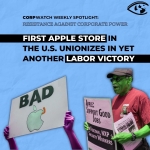US: On Television, Brands Go From Props to Stars
The New York Times
October 2, 2005
By
LATER this month on "The Office," Michael Scott, the painfully clueless regional manager of a paper supply company, will embrace casual Fridays in his own inimitable style. Eager to show off his newly trim physique, particularly his backside, the character - played by Steve Carell - will proudly model his new jeans to his alternately befuddled and appalled employees. And to anyone who will listen, he will proclaim something along the lines of "I love my new Levi's."
This cringe-inducing bit of comedy will have been made possible in part by Levi Strauss. The company and the creators of "The Office," the NBC critical darling, are willing participants in the next generation of product placement. No longer are brands mere props on the set or the supporting stars of reality shows. Advertisers and their representatives are increasingly working with a show's writers and producers and the network's ad sales staff to incorporate products into the story lines of scripted shows as part of more elaborate marketing deals.
What Hollywood and Madison Avenue euphemistically call "brand integration" was hard to miss last season. Gabrielle Solis, Eva Longoria's character on ABC's "Desperate Housewives," found herself hard up for money and reluctantly agreed to don an evening gown and extol the virtues of a Buick LaCrosse at a car display. Amanda Bynes's character on the WB's "What I Like About You" raved about Fruity Pebbles and competed against a friend to be in the next Herbal Essences commercial. And the producers of "Bernie Mac" on Fox wove mentions of Rolaids throughout an episode as they unleashed the dyspeptic Mr. Mac to rant about life's injustices and his stomach pains.
Network, advertising and production executives say that this season, more and more brands will venture outside the confines of 30-second ads. They may have no choice: As technology and clutter blunt the effectiveness and reach of the commercial spots that have underpinned the television business for nearly 50 years, the various players are scrambling to adapt.
The networks, sensing a new revenue stream as traditional advertising spending flattens out, are actively pursuing these steroid-enhanced product placement deals. Advertising companies - from Omnicom to MediaVest to Carat Americas - have started their own branded entertainment divisions to solidify their relationships with their corporate clients, as well as the cash that comes with them. Newcomers like Madison Road Entertainment have popped up to match the desires of Hollywood and marketers and perhaps create their own shows in the process. And producers see in these more sophisticated plugs a way to offset rising production costs.
Not everyone is thrilled with the trend. Some creators of television shows worry that the mercantile impulse could turn storytellers into shills and keep more provocative fare off the big networks. Last Tuesday in New York during what is known as Advertising Week, television writers protested outside a panel about branded entertainment, demanding more say in any such deals as well as a cut in the profits from them. And the Federal Communications Commission has turned a wary eye on a practice it sees as little more than stealth advertising.
But many producers, network executives and advertisers dismiss such criticisms as overblown. "The fact is brands are part of our lives and brands exist in these television environments, so why not showcase them?" said Ben Silverman, chief executive of Reveille, whose shows include "The Office" as well as reality shows like "Biggest Loser" on NBC and "Nashville Star" on USA. "Otherwise, brands will go spend their dollars on Google, and the F.C.C. ain't going to be able to do anything."
IN some ways, this newfangled form of branded entertainment harks back to the beginnings of television. Half a century ago, ad agencies often produced shows like "The Colgate Comedy Hour" and "Texaco Star Theater," in which a chorus line of dapper gas-station attendants opened each show by singing the Texaco jingle ("Oh, we're the men of Texaco, we work from Maine to Mexico") before introducing the host, Milton Berle.
A combination of rising production costs and quiz-show scandals pushed the sponsors out of the show-making business by the late 1950's, and the era of the 30-second ad began. But advertisers' products found their way back into the shows themselves as a cottage industry - product placement firms - developed.
These businesses furnished the apartments, filled the fridges and supplied the cars for sitcoms and dramas. Corporations would barter their wares to television as well as feature films, hoping that the glamour of Hollywood would rub off on their quotidian products. And the studios were able to keep costs down and add a little verisimilitude to the action.
Sometimes, serendipity would strike, and a brand like Junior Mints would end up lodged in the nation's collective consciousness. No advertiser approached the creators of "Seinfeld" to suggest a 1993 episode in which Kramer and Jerry watch helplessly as a Junior Mint falls into the body cavity of Elaine's former boyfriend during an operation. The "Seinfeld" writers came up with the idea, and the product placement firm, AIM Productions, rushed to get clearance from the company, hedging its bets by sending requests to the owners of LifeSavers and M&M's, too, said Patti Ganguzza, the company's president. No money changed hands.
Then, about five years ago, the product placement landscape changed, in large part because of Mark Burnett and "Survivor." By selling sponsorships to advertisers, Mr. Burnett was able to finance much if not all of his show, easing the way for a network - in this case, CBS - to put it on the air without much financial risk. And because success in television is always accompanied by swarms of imitators, the networks latched on to this low-cost programming model.
Despite the fervent wishes of many television critics, reality shows - about everything from C-list celebrities ("The Surreal Life") to ballroom dancers ("Dancing With the Stars") to backbiting businesspeople ("The Apprentice") - still clog the broadcast and cable networks. And they are shamelessly stuffed to bursting with brand tie-ins; indeed, whole episodes can revolve around a product.
During the 2004-2005 television season, more than 100,000 product placements appeared on the six broadcast networks, an increase of nearly 28 percent from the previous season, according to Nielsen Media Research. And in 2004, the value of overall TV product placements rose 46.4 percent, to $1.88 billion, according to the research firm PQ Media.
More are on the way, particularly in scripted shows. Leslie Moonves, co-president and co-chief operating officer of Viacom and chairman of CBS, has predicted in recent months that there will be a "quantum leap" in the number of product placements and that within one or two years, nearly every show on network television will have them. Last month, CBS digitally embedded the logo of the Chevrolet Impala in the scenery of five of its shows, including "CSI."
This headlong embrace, paradoxically, comes at a time when the average household watches more television than ever, according to a report released on Thursday by Nielsen. Yet the financial moorings of the television industry have never been subject to such pressure.
With so many entertainment choices, audience fragmentation continues apace, and advertisers are none too pleased to be paying the same or higher ad rates for shows that are losing viewers. At the same time, technology has given viewers a degree of control over their television - and commercial - watching. Digital video recorders may be in fewer than 10 million households now, but marketers are already preparing for the day when many more viewers are likely to skip right past their 30-second ads.
Major marketers like Procter & Gamble and Unilever have cut their television ad budgets and put more into product placement. For the networks and the studios and producers who create the shows, that is ominous. "The advertising model of 10 years ago is not applicable today," said Bruce Rosenblum, president of Warner Brothers Television Group, which oversees both the WB and the television studio.
"At the end of the day," he added, "if we are unable to satisfy advertisers' appetites to deliver messages in new ways to the viewer, then we're destined to have a broken model."
No template exists for these more elaborate product placement deals, according to interviews with more than two dozen advertisers, network executives, branded-entertainment principals and producers. But in most cases, the advertisers gain a say and, occasionally, veto power over how the product is portrayed.
In return, an advertiser will end up buying more ordinary 30-second ads than it did previously, as well as paying a separate integration fee to the network, which splits the money with the studio. That bounty can rise into the millions of dollars, said Mr. Silverman of Reveille. Or it can help a network keep ad dollars that might have gone to other shows or media.
Sometimes, instead of an integration fee, advertisers will include the show in their marketing efforts, such as mall promotions, magazine ads and newspaper stuffers - much to the networks' delight. "Network dollars are tight. If I get a promotion, that's a big thing for me," said Joe Davola, president of Tollin/Robbins Television, which produces such shows as "Inconceivable" on NBC as well as the WB's "What I Like About You," "Smallville" and "One Tree Hill."
The challenges and contests in reality shows readily lend themselves to brand integration, executives said. Starving, thirsty islanders will gobble and guzzle Doritos and Mountain Dew after vanquishing their opponents in a "Survivor" episode, and the viewer will usually accept the products' presence.
But scripted shows are a trickier endeavor. "When a marketer uses branded entertainment to actually sell a product, the entire exercise will fail," said Jak Severson, chief executive of Madison Road Entertainment. "Audiences are so sophisticated today the last thing they will do is sit and be sold to during an entertainment show."
Jonathan Prince, creator of the recently canceled "American Dreams," is now working with Madison Road; he is one of the most aggressive in weaving brands into his story lines. In the three years when "American Dreams" was on the air, he made Campbell's Soup, the Ford Mustang, Kraft Singles and Oreos significant pieces of the show. "I had seen too much bad product placement, with someone driving a car, holding a soda," he said. "It felt like a commercial - and advertisers already do that well."
Mr. Prince added, "The ones that work are the ones that grow out of character."
For the Campbell's Soup tie-in, which he concocted with NBC, Mr. Prince already had an idea to portray the deviousness of a character, Patty, who is a junior high school student. So he attached a continuing story line in which she bribed schoolmates to send entries that she ghostwrote to the annual Campbell's Soup essay-writing contest, bolstering her chances to win. Her actions had repercussions, and a lesson was learned in this family-friendly series, set in the 1960's.
"American Dreams" got more 30-second ads from Campbell's and was featured in its print and radio advertising as well as on 40 million labels. Colleen Milway, global media director for the Campbell Soup Company, said the story line fit the squeaky-clean image the company wants for the brand. And by eschewing the obvious approach - characters chirping "Mmm, Mmm, Mmm Good," for example - the integration appeared to work. Three times the typical number of people entered the essay-writing contest after the episodes were shown.
"The needle we have to thread is to have a brand integration that is effective enough to have resonance, but - and it's a big but - subtle enough so that it doesn't offend," said Mr. Prince.
Arbitrariness does not help. Last Thursday, on the season premiere of "Will & Grace" on NBC, the new Subway chicken parmigiana sandwich made an unexpected appearance. The writers revealed that Stan, the missing husband of Megan Mullally's character, was alive, kept in hiding by her maid and fed a steady diet of chicken sandwiches.
Measuring a product placement's effectiveness - the domain of companies like iTVX and IAG Research - is still an inexact science. But as with all new fads in the media business, bad money is likely to tumble alongside the good.
"I'm sure there will be integration that will make people cringe," said Robert Riesenberg, president and chief executive of Full Circle Entertainment, a television production company owned by Omnicom. "But over all," he added, "content is going to be governed by taste, by people's desire to engage with television."
The industry is ultimately self-regulating; turn off the viewers, and there won't be a show left to cram with dissonant brand integrations.
Producers and network executives also caution that they need to police themselves, to refrain from grabbing dollars willy-nilly. While ABC has not instituted a quota - and the Sears connection with "Extreme Makeover: Home Edition" has been well received - executives there said they would have a difficult time doing more than one or two a week. "As soon you as you start ramping up the volume, quality starts to suffer," said Dan Longest, senior vice president of integrated marketing at ABC.
ONE car manufacturer approached "The West Wing" last season, with some specific story ideas to weave one of its cars into the show's storytelling. John Wells, the show's executive producer, politely declined.
But when Mr. Wells's other NBC show, "E.R.," wanted the arrogant doctor played by Mekhi Phifer to brag about his new car, the producers went with a Chrysler 300C. "When we tried to do it without mentioning a name, it sounded silly," said Mr. Wells. No money was involved; Chrysler just loaned the car.
For Chrysler, that tacit approval by a character in a scripted show validated its attempts to portray the Chrysler 300 as a hot car. "That's very valuable to us," said Jeff Bell, vice president of Chrysler and Jeep.
The plug may not have matched the boost the Pontiac Solstice received on an episode of "The Apprentice" last season, which led to 1,000 cars being presold in the 41 minutes after the episode ended, according to Steve Tihanyi, general director of marketing alliances and entertainment at General Motors. But, Mr. Bell said, "It's better than a salesman's solicitation."
Producers like Mr. Wells have the clout to pick and choose, and Dick Wolf can keep his three "Law & Order" series free of product placement if he wants. But some in the television industry fret that those with less successful track records or at smaller networks will not be able to fend off aggressive marketers.
Also worrisome is the tendency of advertisers who are creating brand integrations to gravitate toward heartwarming shows like NBC's "Three Wishes," in which the singer Amy Grant ladles out assistance to those in need. "It's got to be noncontroversial," said Mr. Riesenberg of Full Circle, whose productions include "Bound for Glory" on ESPN (with Mr. Silverman's Reveille); the show follows the former football star Dick Butkus as he tries to turn around a high school football team.
Television shows that deal with provocative subjects could find themselves at a financial disadvantage in an environment where networks and studios must rely increasingly on this new source of revenue, Mr. Wells said. "I believe in market forces, but I think the quality of content will suffer," he said.
Mr. Prince, the "American Dreams" creator, said that he had heard similar concerns from fellow writers and producers, but that he did not have much patience for them.
"People who pay the bills get to write notes," he said, but that does not mean a producer has to consent to every brand integration idea. To him, the advertisers are the saviors of scripted television. " 'Desperate Housewives' doesn't need a savior. 'Lost' doesn't need a savior," he said. "It's the middling-rated, expensive, quality shows that network people want to keep on the air, but to them the model doesn't make sense."
Branded integration schemes also face some other foes, like Jonathan S. Adelstein, a commissioner at the F.C.C. "Whether it's classic payola, where a radio station gets a large plasma television to play a certain song, or a corporation pays $100,000 to get its product mentioned on the air, both the station and the network are required by law to disclose that," Mr. Adelstein said.
The networks do disclose promotional considerations. But Mr. Adelstein says the credits whip by so fast that the human eye cannot read them, even with a DVR. "Is that full and fair disclosure? I don't think so," he said. "We need to make sure people are sure they're being sold to."
For Mr. Davola of Tollin/Robbins, the benefits of branded integration outweigh any hypothetical downside. "If people get insulted, they can go watch PBS or go rent an independent movie," he said. "Seriously. This is the real world. I'm not ruining television."
- 180 Media & Entertainment


